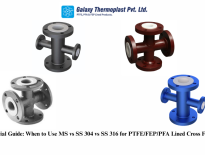Type strainer manufacturers, PFA lined t strainer, and PTFE lined strainer are essential components in industrial filtration systems. These strainers help in removing solids from pipelines, protecting pumps, valves, and equipment from damage. In this guide, we’ll explore the materials used, types of linings, benefits, and tips on how to choose and maintain the right lined Y-type strainer.
What is a Y-Type Strainer?
A Y-type strainer is a device placed in a pipeline to trap unwanted particles from a flowing fluid. It is shaped like the letter “Y”, allowing fluid to flow through while directing particles into a screen section that can be cleaned. These strainers are often used in systems where clean fluid is critical.
Material Options for Body Construction
a) Mild Steel (MS)
- Cost-effective material
- Used when chemical resistance is not needed from the base metal
- Relies completely on the internal lining to protect from corrosion
b) Stainless Steel 304
- Better corrosion resistance than MS
- Suitable for less aggressive or neutral fluids
- Common in food, water treatment, and pharma systems
c) Stainless Steel 316
- Excellent resistance to acids, chlorides, and seawater
- Suitable for marine, high-end industrial, and chemical processes
- Best for highly corrosive environments
Types of Linings Used
a) PTFE (Polytetrafluoroethylene) Lining
- Chemically inert and non-reactive
- Can handle temperatures up to 260°C
- Non-stick surface reduces friction and build-up
- Ideal for general corrosive and chemical service
b) FEP (Fluorinated Ethylene Propylene) Lining
- Similar to PTFE but softer and more flexible
- UV-resistant and partially transparent
- Slightly lower heat resistance than PTFE
- Useful for complex shaped strainers
c) PFA (Perfluoroalkoxy) Lining
- Combines high purity with flexibility and strength
- High-temperature tolerance with excellent chemical resistance
- Suitable for critical applications where durability and purity matter
- More expensive, but highly durable and reliable
Benefits of Lined Y-Type Strainers
- High Corrosion Resistance: Lining protects the internal surface from harsh chemicals.
- Clean Operation: Prevents contamination, making it ideal for sensitive processes.
- Low Maintenance: Reduces the need for frequent part replacements.
- Versatile Use: Compatible with a wide range of fluids and chemicals.
- Supports CIP Systems: Can be cleaned in place without dismantling, useful in food and pharma setups.
How to Choose the Right Combination
| Application Condition | Recommended Combination |
|---|---|
| Cost-Sensitive Projects | MS body + PTFE lining |
| Moderate Corrosive Environments | SS 304 + PTFE or FEP lining |
| Highly Corrosive or Hygienic Applications | SS 316 + PFA lining |
Maintenance & Inspection Tips
- Check the Strainer Screen regularly for clogging and clean if needed.
- Inspect the Lining for any cracks or wear. Damaged lining may lead to corrosion.
- Avoid Mechanical Impact during installation to prevent damage.
- Use Correct Torque when tightening flange bolts to avoid over-stressing the lining.
Final Thoughts
Whether you’re selecting a PTFE lined strainer, a PFE lined t strainer, or checking options from leading Y type strainer manufacturers, it’s important to understand the lining and body materials. Choosing the right combination ensures long-term performance, safety, and reliability in your system.
Lined Y-type strainers offer a smart solution for industries dealing with corrosive fluids. With proper selection and maintenance, these strainers can protect your equipment and ensure smooth flow for years.


